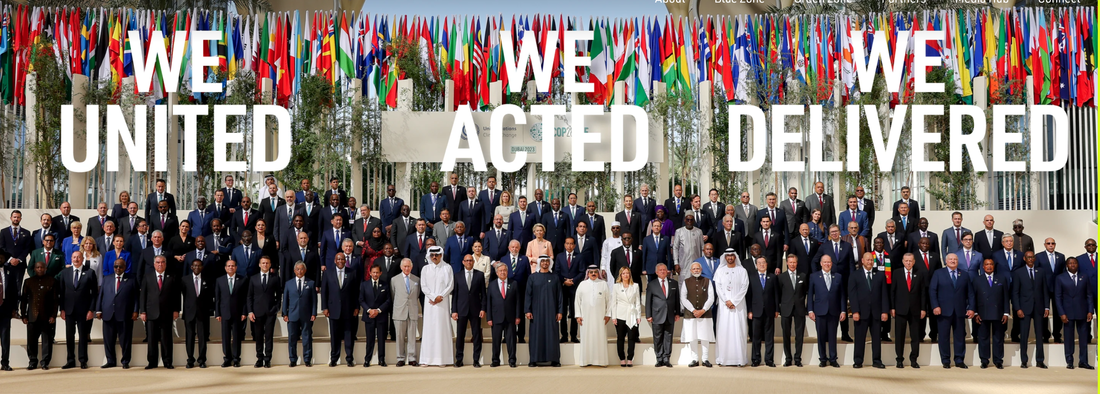Decoding COP 28: A Comprehensive Analysis and Its Implication for Business and Climate Action12/25/2023 Introduction The 28th Conference of the Parties, or COP 28, has just concluded on December 12th. What was that and what is it about? We'll explore all of this in this article. COP 28 represents a milestone in the ongoing global effort to combat climate change. This pivotal UN conference is not just a gathering of political leaders, but also a ground-breaking platform to engage non-party stakeholders, including businesses, cities, investors, and even civil societies, in the mutual pursuit of decarbonization. It is a yearly conference and is hosted in a different country every year. At its core, COP 28 aimed to facilitate actionable climate strategies by fostering open dialogue between various major actors, effectively closing the gap between rhetoric and action on a global scale. This inclusive approach emphasizes the high stakes of climate change and underscores the undeniable truth that its impacts are not confined to borders, and thus, no entity, be it a business or a city, is a mere bystander. Integral to COP 28's mission is the Global Climate Action Agenda, which has been pivotal in galvanizing worldwide commitment toward mitigation, adaptation, and finance goals set by the Paris Agreement (from COP 21). This unique initiative is instrumental in sustaining momentum between COPs, showcasing real-world examples of climate solutions, and mobilizing diverse sectors of society in driving global ambition and action against climate change. Ultimately, COP 28 and the Global Climate Action Agenda symbolize our collective pursuit to create a sustainable future. Outcomes of COP 28 Even though COPs started with a focus on climate, their scope keeps expanding with our understanding that addressing the climate issue is also related to other social and economic issues. COP 28 had four strategic pillars as identified by the conference presidency. Here is a close look at each of them and their implications.
Pledges, Declarations, and Joint StatementsIn the context of the COP, pledges and declarations play a crucial role in setting commitments and intentions by countries and stakeholders to address climate change. These pledges and declarations serve as crucial signals that reveal nations' determination to act on the climate crisis, despite not necessarily being legally binding.
The significance of pledges and declarations lies in their potential to catalyze momentum, inspire innovation, and instigate peer pressure to drive climate action. They signal a collective resolve to engage in comprehensive climate mitigation and adaptation, which could lead to enhanced collaboration and sharing of best practices between different countries. Further, they have the potential to attract investments in clean technology and catalyze new collaborative platforms that support climate action implementation. However, the effectiveness of pledges and declarations ultimately depends on national implementation and enforcement mechanisms. To ensure that they deliver tangible results, it is essential to track progress, frequently update goals, and maintain transparency around implementation. Selected examples of pledges, declarations, and joint statementsYou might be wondering what those pledges, declarations, and joint statements look like. Below are selected examples of those and what each entails.
These are some examples of how various countries and stakeholders worldwide are taking steps towards addressing climate change on multiple fronts. How about you as an entrepreneur or a business One of the best ways that entrepreneurs and businesses can capitalize on COP 28 is to use the outcomes as a guide or a factor in their next endeavors and/or strategic directions. Above all, the COP outcomes can indicate what many future promising opportunities entail. Here are some examples that can be inferred from COP 28 outcomes.
By understanding and acting on COP28's outcomes, you can position yourself favorably for the low-carbon economy on the horizon. More info If you are looking for more information about COP 28, you can check out the official website for the conference here: https://www.cop28.com/en/ If you would like to know more about Climate Change which is also the cause for all the COP conferences, you can check out our Climate Change Course on the TforDesign Platform. You can also find the course on Udemy. P.S. Here is a little inspirational video about the event published by COP28 UAE: By Tayseer Almattar
Tayseer is a passionate designer and educator. He believes that innovation potential can be grown and nurtured within organizations with relevant design innovation processes. LinkedIn: https://www.linkedin.com/in/tayseer-almattar-design-innovation
0 Comments
Leave a Reply. |
AuthorThe following blogs are written by TforDesign team and community members. Categories
All
|
© 2013 - 2024 TforDesign. All rights reserved.
Terms & Conditions | Privacy Policy | Cookie Policy | Sitemap
Terms & Conditions | Privacy Policy | Cookie Policy | Sitemap





 RSS Feed
RSS Feed